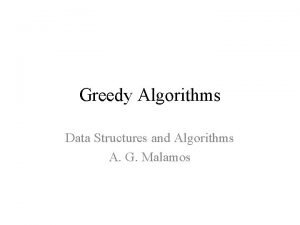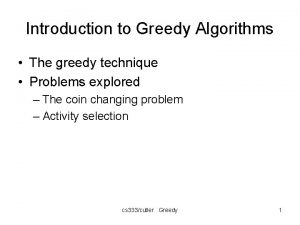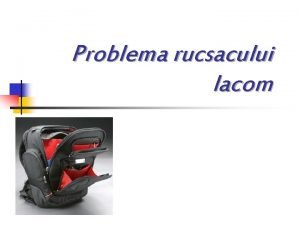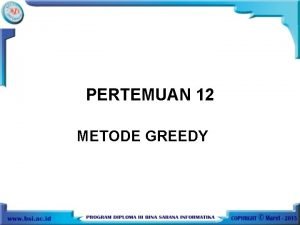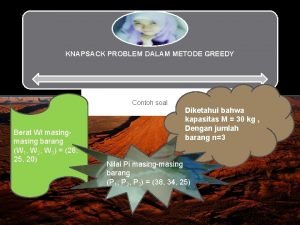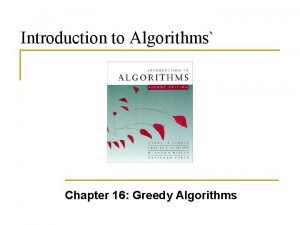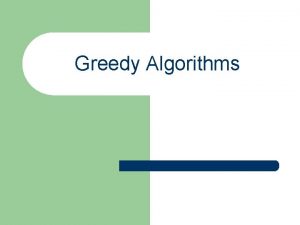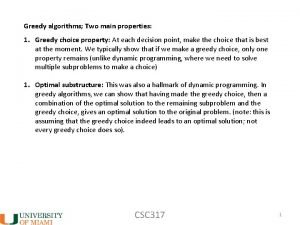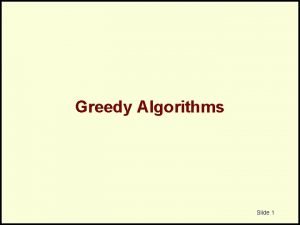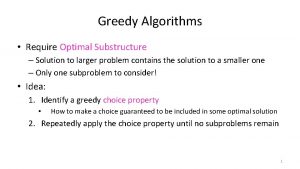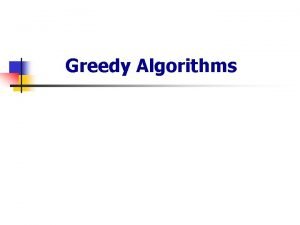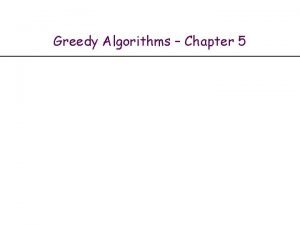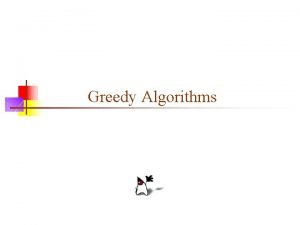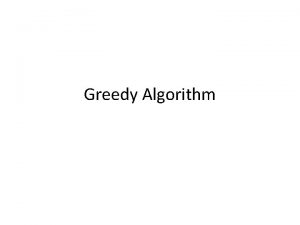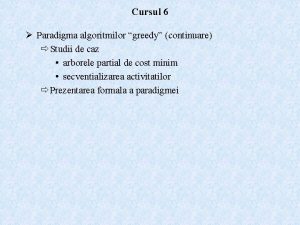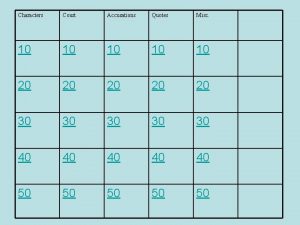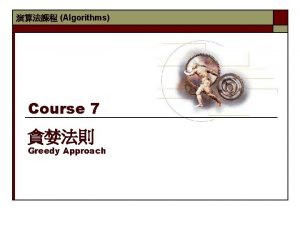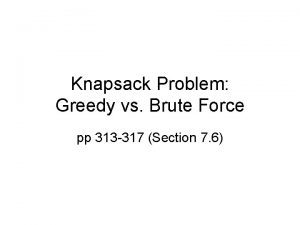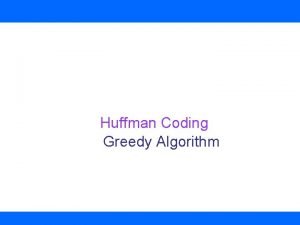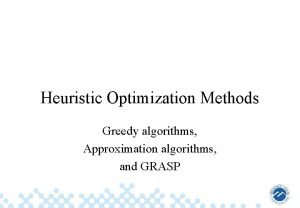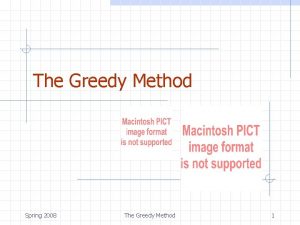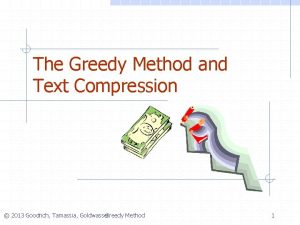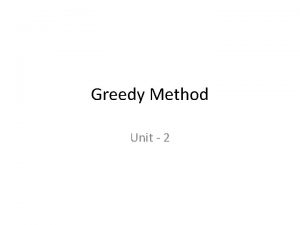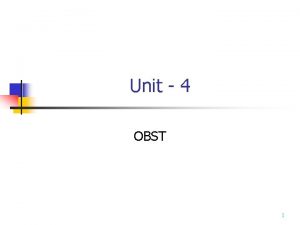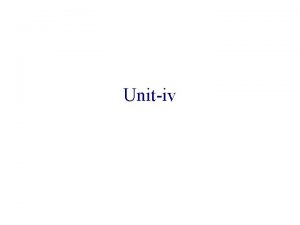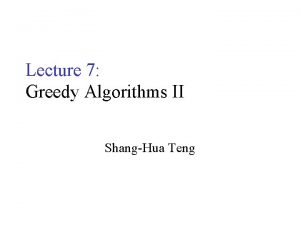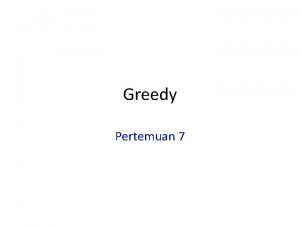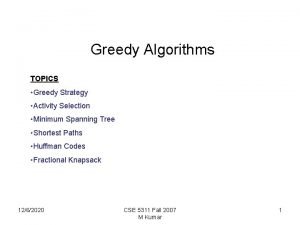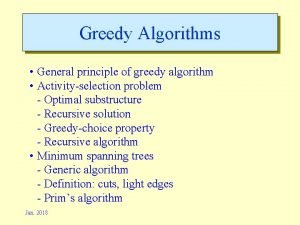Greedy Method 1 Greedy Method n Greedy Principal




































- Slides: 36

Greedy Method 1

Greedy Method n Greedy Principal: are typically used to solve optimization problem. Most of these problems have n inputs and require us to obtain a subset that satisfies some constraints. Any subset that satisfies these constraints is called a feasible solution. We are required to find a feasible solution that either minimizes or maximizes a given objective function. In the most common situation we have:

Greedy Method n n n Subset Paradigm : Devise an algorithm that works in stages Consider the inputs in an order based on some selection procedure Use some optimization measure for selection procedure –At every stage, examine an input to see whether it leads to an optimal solution If the inclusion of input into partial solution yields an infeasible solution, discard the input; otherwise, add it to thepartial solution 3 -3

Greedy Vs Divide and Conquer Greedy Divide and Conquer Used when need to find optimal solution No optimal solution, used when problem have only one solution Does not work parallel by dividing big problem in smaller sub problem and running then parallel Example: Knapsack, Activity selection Example: Sorting, Searching 3 -4

Knapsack problem using Greedy Method 5

The Knapsack Problems n The knapsack problem is a problem of optimization: Given a set of items n, each with a weight w and profit p, determine the number of each item to include in a kanpsack such that the total weight is less than or equal to a given knapsack limit M and the total Profit is maximum.

The Knapsack Problems n The Integer Knapsack Problem Maximize Subject to n n ≤M The 0 -1 Knapsack Problem: same as integer knapsack except that the values of xi's are restricted to 0 or 1. The Fractional Knapsack Problem : same as integer knapsack except that the values of xi's are between 0 and 1.

The knapsack algorithm n The greedy algorithm: Step 1: Sort pi/wi into nonincreasing order. Step 2: Put the objects into the knapsack according to the sorted sequence as possible as we can. n e. g. n = 3, M = 20, (p 1, p 2, p 3) = (25, 24, 15) (w 1, w 2, w 3) = (18, 15, 10) Sol: p 1/w 1 = 25/18 = 1. 39 p 2/w 2 = 24/15 = 1. 6 p 3/w 3 = 15/10 = 1. 5 Optimal solution: x 1 = 0, x 2 = 1, x 3 = 1/2 total profit = 24 + 7. 5 = 31. 5 3 -8

GREEDY ALGORITHM TO OBTAIN AN OPTIMAL SOLUTION for Job Scheduling n n Consider the jobs in the decreasing order of profits subject to the constraint that the resulting job sequence J is a feasible solution. In the example considered before, the decreasing profit vector is (100 27 p 1 p 4 15 10) p 3 p 2 (2 1 d 4 2 1) d 3 d 2 9

GREEDY ALGORITHM TO OBTAIN AN OPTIMAL SOLUTION (Contd. . ) J = { 1} is a feasible one J = { 1, 4} is a feasible one with processing sequence ( 4, 1) J = { 1, 3, 4} is not feasible J = { 1, 2, 4} is not feasible J = { 1, 4} is optimal 10

Activity Selection Using Greedy Method 11

The activity selection problem n n Problem: n activities, S = {1, 2, …, n}, each activity i has a start time si and a finish time fi, s i fi. Activity i occupies time interval [si, fi]. i and j are compatible if si fj or sj fi. The problem is to select a maximum-size set of mutually compatible activities 3 -12

Example: i si fi 1 1 4 2 3 5 3 0 6 4 5 7 5 3 8 6 5 9 7 8 9 10 11 6 8 8 2 12 10 11 12 13 14 The solution set = {1, 4, 8, 11} Algorithm: Step 1: Sort fi into nondecreasing order. After sorting, f 1 f 2 f 3 … f n. Step 2: Add the next activity i to the solution set if i is compatible with each in the solution set. Step 3: Stop if all activities are examined. Otherwise, go to step 2. Time complexity: O(nlogn) 3 -13

Solution of the example: i 1 2 3 si 1 3 0 fi 4 5 6 accept Yes No No 4 5 7 8 9 10 11 5 3 6 8 8 2 12 7 8 10 11 12 13 14 Yes No No Yes Solution = {1, 4, 8, 11} 3 -14

Dynamic programming 15

Dynamic Programming § Principal: Dynamic Programming is an algorithmic paradigm that solves a given complex problem by breaking it into subproblems and stores the results of subproblems to avoid computing the same results again. § Following are the two main properties of a problem that suggest that the given problem can be solved using Dynamic programming. 1) Overlapping Subproblems 2) Optimal Substructure

Dynamic Programming n n 1) Overlapping Subproblems: Dynamic Programming is mainly used when solutions of same subproblems are needed again and again. In dynamic programming, computed solutions to subproblems are stored in a table so that these don’t have to recomputed. 2) Optimal Substructure: A given problems has Optimal Substructure Property if optimal solution of the given problem can be obtained by using optimal solutions of its subproblems. 3 -17

The principle of optimality n n Dynamic programming is a technique for finding an optimal solution The principle of optimality applies if the optimal solution to a problem always contains optimal solutions to all subproblems 18

Differences between Greedy, D&C and Dynamic n n n Greedy. Build up a solution incrementally, myopically optimizing some local criterion. Divide-and-conquer. Break up a problem into two sub-problems, solve each subproblem independently, and combine solution to sub-problems to form solution to original problem. Dynamic programming. Break up a problem into a series of overlapping sub-problems, and build up solutions to larger and larger sub -problems. 19

Divide and conquer Vs Dynamic Programming n n Divide-and-Conquer: a top-down approach. Many smaller instances are computed more than once. Dynamic programming: a bottom-up approach. Solutions for smaller instances are stored in a table for later use.

0/1 knapsack using Dynamic Programming 21

0 - 1 Knapsack Problem Knapsack problem. Given n objects, Item i weighs wi > 0 and has Profit pi > 0. Knapsack has capacity of M. n Xi = 1 if object is placed in the knapsack otherwise Xi = 0 Maximize n Subject to 22

0 - 1 Knapsack Problem n n Si =pair(p, w) i. e. profit and wieght Si 1 ={(P, W)|(P+pi+1 , W+wi+1)} 3 -23

0/1 Knapsack - Example Item 1 Profit 1 Weight 2 2 2 3 3 5 4 • No of object n=3 • Capacity of Knapsack M = 6 24

0/1 Knapsack – Example Solution n S 0 ={(0, 0)} n S 0 1 will be obtained be adding Profit Weight of First object to S 0 n S 01 ={(1, 2)} n S 1 will be obtained by merging S 0 and S 01 n n n n n S 1 ={(0, 0), (1, 2)} S 11 will be obtained be adding Profit Weight of second object to S 11 ={(2, 3), (3, 5)} S 2 will be obtained by merging S 1 and S 11 S 1 ={(0, 0), (1, 2), (2, 3), (3, 5)} S 21 will be obtained be adding Profit Weight of third object to S 21 ={(5, 4), (6, 6), (7, 7), (8, 9)} S 3 will be obtained by merging S 2 and S 21 S 3 ={(0, 0), (1, 2), (2, 3), (3, 5), (5, 4), (6, 6), (7, 7), (8, 9)} 3 -25

0/1 Knapsack – Example Solution n n n Pair(7, 7) and (8, 9) will be deleted as it exceed weight of Knapsack(M=6) Pair(3, 5) will be deleted by dominance Rule So : S 3 ={(0, 0), (1, 2), (2, 3), (5, 4), (6, 6)} Last pair is (6, 6) which is generated by S 3 , so X 3=1 Now subtract profit and weight of third object from(6, 6) (6 -5, 6 -4)=(1, 2) is generated by S 1, so X 1=1 Now subtract profit and weight of third object from(1, 2) (1 -1, 2 -2)=(0, 0) As nothing is generated by S 2 so X 2=0 Answer is : Total Profit is 6 object 1 and 3 is selected to put into knapsack. 3 -26

Optimal Binary Search Tree (OBST) using Dynamic Programming 27

Optimal binary search trees • Example: binary search trees for 3, 7, 9, 12; 7 -28

• A full binary tree may not be an optimal binary search tree if the identifiers are searched for with different frequency • Consider these two search trees, If we search for each identifier with equal probability – In first tree, the average number of comparisons for successful search is 2. 4. – Comparisons for second tree is 2. 2. • The second tree has 1 2 2 3 4 (1+2+2+3+4)/5 = 2. 4 1 – a better worst case search time than 2 the first tree. – a better average behavior. (1+2+2+3+3)/5 = 2. 2 2 3 3

Optimal binary search trees (5/14) • In evaluating binary search trees, it is useful to add a special square node at every place there is a null links. – We call these nodes external nodes. – We also refer to the external nodes as failure nodes. – The remaining nodes are internal nodes. – A binary tree with external nodes added is an extended binary tree

Optimal binary search trees (6/14) • External / internal path length – The sum of all external / internal nodes’ levels. • For example – Internal path length, I, is: I=0+1+1+2+3=7 – External path length, E, is : 1 E = 2 + 4 + 3 + 2 = 17 • A binary tree with n internal 2 2 nodes are related by the formula E = I + 2 n 4 0 1 2 3 4

Optimal binary search trees • n identifiers are given. Pi, 1 i n : Successful Probability Qi, 0 i n : Unsuccessful Probability Where, 7 -32

• Identifiers : 4, 5, 8, 10, 11, 12, 14 • Internal node : successful search, Pi • External node : unsuccessful search, Qi n The expected cost of a binary tree: n The level of the root : 1 7 -33

The dynamic programming approach for Optimal binary search trees • To solve OBST , requires to find answer for Weight (w), Cost (c) and Root (r) by: • W(i, j) =p(j) +q(j) +w(i, j-1) • C(i, j)= min {c(i, k-1)+c(k, j)}+w(i, j) …. . i<k<=j • r = k (for which value of c(i, j) is small 7 -34

Optimal binary search trees (13/14) • Example – Let n = 4, (a 1, a 2, a 3, a 4) = (do, for, void, while). Let (p 1, p 2, p 3, p 4) = (3, 3, 1, 1) and (q 0, q 1, q 2, q 3, q 4) = (2, 3, 1, 1, 1). – Initially wii = qi , cii = 0, and rii = 0, 0 ≤ i ≤ 4 w 01 = p 1 + w 00 + w 11 = p 1 + q 1 + w 00 = 8 c 01 = w 01 + min{c 00 +c 11} = 8, r 01 = 1 w 12 = p 2 + w 11 + w 22 = p 2 +q 2 +w 11 = 7 c 12 = w 12 + min{c 11 +c 22} = 7, r 12 = 2 w 23 = p 3 + w 22 + w 33 = p 3 +q 3 +w 22 = 3 c 23 = w 23 + min{c 22 +c 33} = 3, r 23 = 3 w 34 = p 4 + w 33 + w 44 = p 4 +q 4 +w 33 = 3 c 34 = w 34 + min{c 33 +c 44} = 3, r 34 = 4

Optimal binary search trees (14/14) • • • wii = qi wij = pk + wi, k-1 + wkj cij = wij + cii = 0 rij = l (a 1, a 2, a 3, a 4) = (do, for, void, while) (p 1, p 2, p 3, p 4) = (3, 3, 1, 1) (q 0, q 1, q 2, q 3, q 4) = (2, 3, 1, 1, 1) 2 1 3 4 The optimal search tree as the result Computation is carried out row-wise from row 0 to row 4
 Greedy approach
Greedy approach Dynamic programming vs divide and conquer
Dynamic programming vs divide and conquer Greedy method in data structure
Greedy method in data structure Knapsack problem ppt
Knapsack problem ppt Greedy algorithm
Greedy algorithm Advantages and disadvantages of glucose oxidase method
Advantages and disadvantages of glucose oxidase method Brown sauce derivatives
Brown sauce derivatives Disadvantages of symposium
Disadvantages of symposium The greedy snake
The greedy snake Where is the greedy marker
Where is the greedy marker Greedy best first search
Greedy best first search Se d
Se d Optimal on tape storage problem adalah
Optimal on tape storage problem adalah Contoh soal knapsack problem
Contoh soal knapsack problem Kassim and the greedy dragon
Kassim and the greedy dragon Greedy algorithm
Greedy algorithm Greedy algoritmus
Greedy algoritmus Advantage and disadvantage of greedy algorithm
Advantage and disadvantage of greedy algorithm Greedy choice property example
Greedy choice property example Activity selection problem greedy algorithm example
Activity selection problem greedy algorithm example Exchange argument greedy
Exchange argument greedy Greedy algorithm
Greedy algorithm Interval scheduling greedy algorithm
Interval scheduling greedy algorithm List of greedy algorithms
List of greedy algorithms Greedy function
Greedy function Greedy best first search
Greedy best first search Algoritmul greedy
Algoritmul greedy Thomas putnam greedy quotes
Thomas putnam greedy quotes Is greedy a character trait
Is greedy a character trait Forbidden latency
Forbidden latency Greedy algorithms
Greedy algorithms Activity selection problem greedy algorithm
Activity selection problem greedy algorithm Algorithm
Algorithm Greedy algorithm vs brute force
Greedy algorithm vs brute force Huffman coding using greedy algorithm
Huffman coding using greedy algorithm Greedy heuristic
Greedy heuristic Greedy algorithm vs dynamic programming
Greedy algorithm vs dynamic programming


